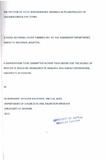The pattern of chest radiographic findings in pulmonology of children under five years

View/
Date
2012Author
Macharia, Margaret M
Type
ThesisLanguage
en_USMetadata
Show full item recordAbstract
Background
Respiratory disease, primarily pneumonia. is the mosl common cause of morbidity and mortality in children less than 5 years old in developing countries resulting in an estimated four million deaths annually as stipulated in an interim programme lor control of acute respiratory infections in Geneva, World Health Organization 199 J. Chest radiography plays a vital role in the management of pulmonary conditions III children and is usually the initial and best available
method for diagnosis.
Objectives
The objectives of this study were to determine the chest radiographic patterns in pulmonary disease in children less than 5 years, distribution by age and correlation with provisional clinical diagnosis.
Methodology
A cross-sectional study was carried out al Kcnyalla National I lospital radiology department, over a period or six months between May 20 I I and October 20 I I. All radiographs of children under 5 years at the Kcnyaua National Ilospital radiology department who met the selection criteria during the study period were included in the study alter signing an informed consent.
The sample size was calculated using a formula based on the prevalence of respiratory infections in children less than 5 years. Each radiograph was reviewed by the researcher and a consultant radiologist. The radiological findingᄏ were recorded in the data collecting form [or each participant. Data was eventually analyzed using the statistical package for social sciences (SPSS) computer software package and the results presented in form of charts and tables.
Results
During the 6 months study period, a total of 315 patients were recruited. The male: female ratio was 1.2:1. The age distribution ranged from 3 days to 59months with a mean age of 14.21 months and a median age of 10 months. Most children were between 6 montbs and 59 months of age accounting for 70% of the cases.
Bilateral lung pathology was seen in more than half of the children (54.6%) unlike unilateral disease which was in 26% of cases. Normal radiographs were reported in 19.4% of the participants. The most predominant radiographic pattern was multiple patchy alveolar infiltrates at 42.86% followed by abnormal aeration (mainly hyperinflation) at 16.83% and peri bronchial and interstitial patterns at 15.56%. There were no radiographic patterns of lung cavities or lung masses. Disease complications were rare with pleural effusion being predominant at 7.94%. Hilar adenopathy was reported in six cases with pulmonary disease as a secondary sign.
Only two radiographic patterns showed significant statistical correlation with clinical diagnosis provided, with multiple patchy alveolar patterns having a p value of 0.004 while abnormal aeration pattern had a p value of 0.001.
Discussion
Chest radiography is the initial and often the only imaging modality used in the evaluation of respiratory conditions in children under 5 years. It constitutes 25-35% of the volume of any general radiology department. This study emphasizes the need for radiological and clinical correlation in management of the patients considering the significant number of normal radiographs. All the cases studied had infective conditions .No lung masses were seen as chest tumors are rare in children less than 5 years.
Conclusion
This study demonstrated that all the pulmonary conditions seen in children were amendable to medical treatment as opposed to surgical intervention demonstrating one of the applications of chest radiography in children less than 5 years. A significant number of participants with normal radiographs had clinical disease hence the multidisciplinary action in patient management. Pulmonary complications were rare; therefore follow up routine radiographs are not required post treatment. Multiple patchy alveolar infiltrates was the predominant pattern.
Recommendations
Inter observer variability observed in the description of radiographic patterns could be studied further lung aspirates studies and correlation with chest radiographic patterns if undertaken would greatly assist in the rational use of antimicrobial therapy.
Publisher
University of Nairobi, Kenya
